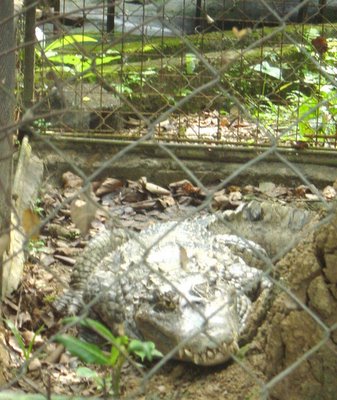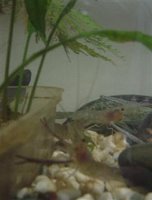I will eventually get around to posting something about my freshwater shrimp, but I thought I’d start off with the real kings of crustacean pets – crayfish. Shrimp are useful… but crayfish are just captivating.
Pros:
Industrious and very active, crayfish provide the observer with thrilling and captivating behaviours to watch.
Cons:
Not the easiest pet to keep, water quality is essential with crayfish. If your oxygen level drops or if pollutants build up you will loose your crayfish – I’ve lost one myself.
Housing:
The species I’ve got is completely aquatic, so my aquarium setup is for a purely aquatic species. However, certain species may temporarily venture out on land. As I mentioned above, water quality is essential, but mine do not take kindly to a pump being placed in their 15 gallon aquarium (fine for 1 crayfish – I suggest you always keep them separate as they may fight). Therefore, I use feeder fish to ensure that the water is suitable. They can be used like a miner’s canary – if they start swimming close to the surface, trying to gulp in oxygen-rich water at the top, it’s about time you changed two thirds of the water.  I don’t usually wait for my fish to start ringing the alarm bells, I usually just change half the water three times a week (the crayfish don’t enjoy this much, but I don’t like to take risks. Avoid strong water currents, especially if you decide to use a pump).
I don’t usually wait for my fish to start ringing the alarm bells, I usually just change half the water three times a week (the crayfish don’t enjoy this much, but I don’t like to take risks. Avoid strong water currents, especially if you decide to use a pump).
In their aquarium crayfish must be given the opportunity to dig. My aquaria are set up in three sections. The first is just plastic (see photo), but the crayfish actually seem to enjoy this. The second is a flat slab of decorative rock. The third is about an inch of gravel. They seem to love to climb up sticks and plants towards the surface. I guess it given them a better vantage point from which to catch feeder fish… However freshwater plants + crayfish = mess. Use very well washed plastic plants (unless you want the crayfish to eat them, in which case most live plants will do).
I keep the water at Philippine room temperature – about 20oC usually. Make sure to remove the shed shell immediately when they shed to preserve water quality (I usually just change the water immediately after they shed).
Feeding:
My crayfish will eat very nearly anything they can get their pincers on (that would probably include my finger). Their absolute favourite if bloodworms, but I’m not too keen on feeding them the same food all the time. They occasionally get their pincers on a feeder fish (which probably illustrates why they are called ‘feeder fish’). I give them a small piece of lettuce to toy with each week. Otherwise their stapes are two types of fish food – floating pellets they compete for with the fish and sinking pellets they have to look for among the gravel. They seem to do fine on that.
Final Words of Advice:
Avoid the pincers! Those things are painfully powerful, believe you me. Especially if you’ve got a relatively large crayfish. However, you can still pick them up relatively safely. If you grab them with your thumb and index finger on the main exoskeleton plate – right above and behind the pincers – they cannot reach you. They will try, and they will get unnervingly close to succeeding, but they cannot reach you. When a sinking pellet happens to land on them they get so angry at not being able to reach it that they start blowing bubbles to try and bump it of…





